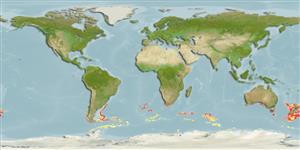>
Zeiformes (Dories) >
Oreosomatidae (Oreos) > Pseudocyttinae
Etymology: Pseudocyttus: Greek, pseudes = false + Greek, kyttaros, kytos = a convex cavity.
Environment: milieu / climate zone / depth range / distribution range
Ökologie
seewasser bathydemersal; ozeanodrom (Ref. 51243); tiefenbereich 400 - 1500 m (Ref. 5194), usually 900 - 1100 m (Ref. 36731). Deep-water; 34°S - 67°S, 90°W - 176°W (Ref. 27159)
Southwest Atlantic: off Uruguay to Argentina and the Falklands. Southeast Atlantic: Namibia to South Africa, including the northern part of Walvis Ridge (Ref. 6545). South Pacific: off southern Chile, Bellingshausen and Australian-Antarctic Basin to New Zealand, New South Wales and Tasmania, Australia and the Kerguelen Islands.
Length at first maturity / Size / Gewicht / Alter
Maturity: Lm 40.0 range ? - 41 cm
Max length : 68.0 cm TL Männchen/unbestimmt; (Ref. 58312); common length : 40.0 cm TL Männchen/unbestimmt; (Ref. 9258); max. veröff. Gewicht: 5.0 kg (Ref. 6390); max. veröff. Alter: 100 Jahre (Ref. 27140)
Rückenflossenstacheln (insgesamt) : 5 - 7; Rückenflossenweichstrahlen (insgesamt) : 33 - 36; Afterflossenstacheln: 2 - 3; Afterflossenweichstrahlen: 31 - 34; Wirbelzahl: 40 - 43. First dorsal spine longer than second dorsal spine. Opercles fully scaled (Ref. 27159).
Female adult chocolate brown in color with darker fins; prejuveniles silvery with numerous dark spots of various sizes which become larger with age (Ref. 6548).
Inhabit continental slopes of all southern continents (Ref. 6545). Adults found near the bottom; juveniles near the surface, usually in association with krill (Ref. 5194). Feed mainly on salps (Ref. 27150). Eggs float near the sea surface and larvae also inhabit surface waters (Ref. 6390). There is no vertical migration during the day or night (Ref. 27150).
Displays seasonally synchronised reproduction (Ref. 6390).
Heemstra, P.C., 1990. Oreosomatidae. p. 226-228. In O. Gon and P.C. Heemstra (eds.) Fishes of the Southern Ocean. J.L.B. Smith Institute of Ichthyology, Grahamstown, South Africa. (Ref. 5194)
IUCN Rote Liste Status (Ref. 130435: Version 2024-2)
Bedrohung für Menschen
Harmless
Nutzung durch Menschen
Fischereien: kommerziell
Tools
Zusatzinformationen
Download XML
Internet Quellen
Estimates based on models
Preferred temperature (Ref.
123201): 2.1 - 6.1, mean 4.2 °C (based on 189 cells).
Phylogenetic diversity index (Ref.
82804): PD
50 = 1.0010 [Uniqueness, from 0.5 = low to 2.0 = high].
Bayesian length-weight: a=0.01995 (0.00813 - 0.04898), b=2.99 (2.77 - 3.21), in cm total length, based on LWR estimates for this (Sub)family-body shape (Ref.
93245).
Trophic level (Ref.
69278): 3.6 ±0.47 se; based on food items.
Widerstandsfähigkeit (Ref.
120179): sehr niedrig, Verdopplung der Population dauert mehr als 14 Jahre. (K=0.07; tmax=100; tm=31; Fec=6,000).
Fishing Vulnerability (Ref.
59153): High to very high vulnerability (72 of 100).
Climate Vulnerability (Ref.
125649): Moderate vulnerability (39 of 100).
Nutrients (Ref.
124155): Calcium = 16.2 [8.5, 36.6] mg/100g; Iron = 0.416 [0.153, 0.905] mg/100g; Protein = 17.2 [14.6, 20.0] %; Omega3 = 0.332 [0.167, 0.702] g/100g; Selenium = 24.3 [9.3, 71.5] μg/100g; VitaminA = 11.1 [1.8, 67.9] μg/100g; Zinc = 0.335 [0.207, 0.526] mg/100g (wet weight);
